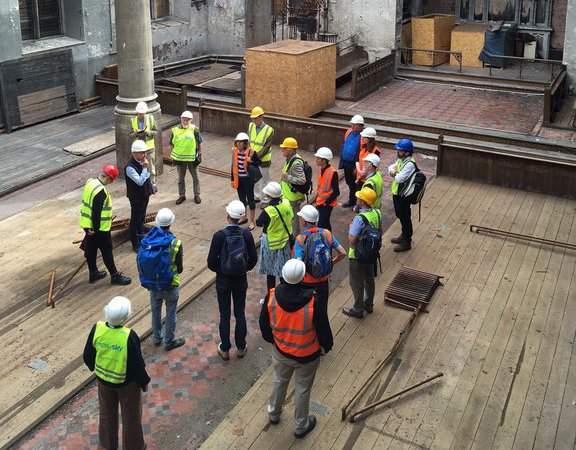
Once a year the Archdeacon arranges for the Diocesan Advisory Committee to visit churches of special interest which this year was an unusual group in central Bristol.
Medieval St Michael on the Mount Without had long been closed and was burnt down last year. In our hard hats and high viz jackets we found the spacious and majestic Georgian interior largely intact, having lost only the north aisle and nave roof. Janey Hiller, responsible for closed churches and George Chedburn architect, told us that the insurance would allow a temporary roof to keep out the rain, whilst the process to find a new user continued, but that it would need more flexibility amongst all those concerned if this was to be concluded any time soon.
St James Priory, said to be Bristols oldest building was adopted by a group devoted to creating a place of peace in the city and to helping the homeless. Susan Jotcham told us in most moving terms of her call and struggle to provide for those in need and then to face the collapsing church roof through the agonising grant process - won at the last minute! The results are a magnificent restoration, a good cup of coffee and the continuing work to help those in need.
Christ Church with St Ewen in Broad Street; a Patey masterpiece of delicate Georgian plaster domes and gilt decoration, is next to the site of the High Cross and one of the oldest church sites in Bristol On hand were Rev John Pedlar; Margaret Dymond, warden of Christ Church; Martin Crossley -Evans, warden of St Ewen who gave us a riveting account of the contents of the church, distributed to other churches by the Victorians and begged back during the 1920s. It is intended that the famous Quarter Jacks also missing from their external gallery will soon be returned.
The delightful and very early church of St John on the Wall with its fine crypt and the only remaining city gate which it also owns, was described by Emma Brown of Churches Conservation Trust. Whilst closed, it is still consecrated for worship and is regularly opened to the public, using mostly volunteers. It is also responsible for the outlet in Nelson Street of St Johns Conduit. For a time during the last war, it was the only supply of water to the old city and continued to run until the 1970s, since when it has been dry, the cause of which is being sought.
We were welcomed to St Stephens, the church next to The Centre with the splendid crenelated tower, by Vanessa Stevenson, Warden and David McLaughlin, previous architect, who gave us a lively talk on its history, present and developing possibilities and who hoped that by modernising it would become more relevant to new generations.
St Marks on College Green, known generally as The Lord Mayors Chapel is the only municipally owned church in the country and is a historic treasure house, which is regularly open to the public.
Our thanks go to The Archdeacon and to Janet Saxon for organising an enjoyable and thought provoking day out, showing us that all those responsible for historic buildings are faced with increasingly complex regulations; range of necessary permissions; of consultees and of finding the money. The DAC is always there to help and it may be that in future it will be able to take a more positive role in supporting and encouraging this important but challenging work.
Peter Floyd, member of DAC
Get involved
If you would like to learn more about how to become a member of DAC, you contact the Archdeacon at christine.froude@bristoldiocese.org.